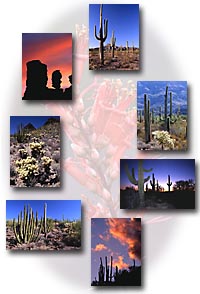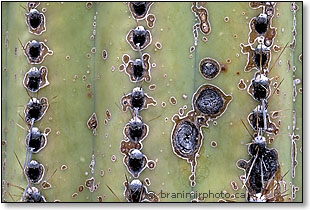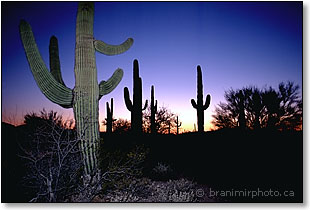
 Saguaro
cactus and life in the Sonoran Desert
Saguaro
cactus and life in the Sonoran Desert
Tall sentinels of the Sonoran, saguaro cacti, are the majestic monarchs of the desert. Fully grown plants can reach heights of 15 m (50 ft.) and weigh as much as 10,000 kg (22,000 lb). The flower of the saguaro is the state flower of Arizona.
Saguaro exhibits special adaptations designed for survival in harsh conditions. With less than 30 cm (12 inches) of rain fall in a typical year, water is the most precious desert commodity. Much of the cactus' ability to survive in the desert relies in it's ability to acquire and store water. Precious liquid is collected by roots that lie about 10 cm (~ 3 inches) below the surface, and stretch as far out as the plant is tall. Accordion-like structure allows the plant to expand and hold the necessary water in a gelatin-type substance in its trunk and arms. After a single rain storm, each plant can collect and store enough water in it's spongy tissues to sustain it for a whole year.
To reduce water loss through transpiration, saguaro, like other cacti, have no conventional leaves. The food-making process of photosynthesis is performed in the trunk and branches. Waxy skin and spines on the surface protect the plant from hungry animals, provide shade, and shield it from drying winds (image above).
Many species rely on the saguaro cactus for their survival. Big flowers open during the night in May and June, only to die off the next afternoon. During that short time, white-winged doves, long-nosed bats, honeybees, and moths feed on rich nectar inside the flower. The fruit of the saguaro ripens in summer, producing as many as 2,000 seeds on which coyotes, foxes, javelinas, and other animals feed on. Besides providing nourishment, saguaro plants with their immense trunks provide home and shelter to many small creatures. The Gila woodpecker and the gilded flicker bore holes to make their nests in the trunk or branches. When these holes are abandoned, other birds and smaller animals move in and find refuge from extreme outside temperatures.
Image: sunset in Sonoran Desert. Fill-in flash was used to bring in some light on the cactus in foreground.
11 January, 2011
Contact us ![]() Privacy policy
Privacy policy ![]() Terms of use
Terms of use
Copyright © Branimir Gjetvaj, all rights reserved
www.branimirphoto.ca

